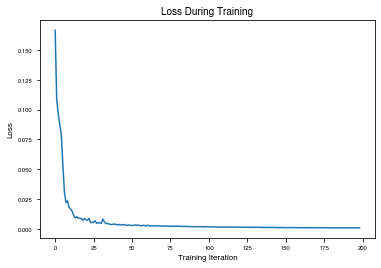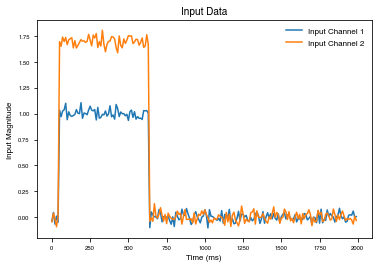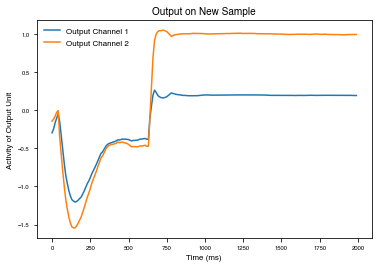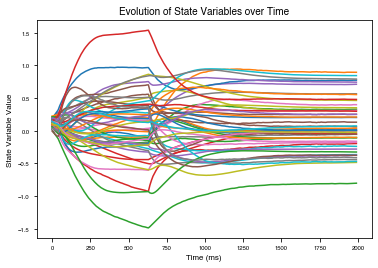Simple Example
This example walks through the steps and options involved in setting up and training a recurrent neural network on a cognitive task.
Most users will want to define their own tasks, but for the purposes of getting familiar with the package features, we will use one of the built-in tasks, the 2-alternative forced choice Perceptual Discrimination task.
This example will use the Basic implementation of RNN. If you are new to RNNs, we recommend you stick with the Basic implementation. PsychRNN also includes BasicScan and LSTM implementations of RNN. If you want to use a different architecture, you can define a new model, but that should not be necessary for most use cases.
[2]:
from psychrnn.tasks.perceptual_discrimination import PerceptualDiscrimination
from psychrnn.backend.models.basic import Basic
import tensorflow as tf
from matplotlib import pyplot as plt
%matplotlib inline
Set Seeds (optional)
We can optionally specify the seeds so that our example is reproducible:
[3]:
import numpy as np
import random
seed=2020
tf.compat.v2.random.set_seed(seed)
random.seed(seed)
np.random.seed(seed)
Initialize Task
First we define some global parameters that we will use when setting up the task and the model:
[4]:
dt = 10 # The simulation timestep.
tau = 100 # The intrinsic time constant of neural state decay.
T = 2000 # The trial length.
N_batch = 50 # The number of trials per training update.
N_rec = 50 # The number of recurrent units in the network.
name = 'basicModel' # Unique name used to determine variable scope for internal use.
[5]:
pd = PerceptualDiscrimination(dt = dt, tau = tau, T = T, N_batch = N_batch) # Initialize the task object
Initialize Model
When we initialize the model, we pass in a dictionary of parameters that will determine how the network is set up.
Set Up Network Parameters
PerceptualDiscrimination.get_task_params() puts the passed in parameters and other generated parameters into a dictionary we can then use to initialize our Basic RNN model.
[6]:
network_params = pd.get_task_params()
print(network_params)
{'N_batch': 50, 'N_in': 2, 'N_out': 2, 'dt': 10, 'tau': 100, 'T': 2000, 'alpha': 0.1, 'N_steps': 200, 'coherence': None, 'direction': None, 'lo': 0.2, 'hi': 1.0}
We add in a few params that any RNN needs but that the Task doesn’t generate for us.
[7]:
network_params['name'] = name # Unique name used to determine variable scope.
network_params['N_rec'] = N_rec # The number of recurrent units in the network.
There are some other optional parameters we can add in. Additional parameter options like those for biological constraints, loading weights, and other features are also available:
[8]:
network_params['rec_noise'] = 0.0 # Noise into each recurrent unit. Default: 0.0
network_params['W_in_train'] = True # Indicates whether W_in is trainable. Default: True
network_params['W_rec_train'] = True # Indicates whether W_rec is trainable. Default: True
network_params['W_out_train'] = True # Indicates whether W_out is trainable. Default: True
network_params['b_rec_train'] = True # Indicates whether b_rec is trainable. Default: True
network_params['b_out_train'] = True # Indicates whether b_out is trainable. Default: True
network_params['init_state_train'] = True # Indicates whether init_state is trainable. Default: True
network_params['transfer_function'] = tf.nn.relu # Transfer function to use for the network. Default: tf.nn.relu.
network_params['loss_function'] = "mean_squared_error"# String indicating what loss function to use. If not `mean_squared_error` or `binary_cross_entropy`, params["loss_function"] defines the custom loss function. Default: "mean_squared_error".
network_params['load_weights_path'] = None # When given a path, loads weights from file in that path. Default: None
# network_params['initializer'] = # Initializer to use for the network. Default: WeightInitializer (network_params) if network_params includes W_rec or load_weights_path as a key, GaussianSpectralRadius (network_params) otherwise.
Initialization Parameters
When network_params['initializer'] is not set, the following optional parameters will be passed to the initializer. See WeightInitializer for more details. If network_params['W_rec'] and network_params['load_weights_path'] are not set, these parameters will be passed to the GaussianSpectralRadius Initializer. Not all
optional parameters are shown here. See Biological Constraints and Loading Model with Weights for more options.
[9]:
network_params['which_rand_init'] = 'glorot_gauss' # Which random initialization to use for W_in and W_out. Will also be used for W_rec if which_rand_W_rec_init is not passed in. Options: 'const_unif', 'const_gauss', 'glorot_unif', 'glorot_gauss'. Default: 'glorot_gauss'.
network_params['which_rand_W_rec_init'] = network_params['which_rand_init'] # 'Which random initialization to use for W_rec. Options: 'const_unif', 'const_gauss', 'glorot_unif', 'glorot_gauss'. Default: which_rand_init.
network_params['init_minval'] = -.1 # Used by const_unif_init() as minval if 'const_unif' is passed in for which_rand_init or which_rand_W_rec_init. Default: -.1.
network_params['init_maxval'] = .1 # Used by const_unif_init() as maxval if 'const_unif' is passed in for which_rand_init or which_rand_W_rec_init. Default: .1.
Regularization Parameters
Parameters for regularizing the loss are passed in through network_params as well. By default, there is no regularization. Below are options for regularizations to include. See Regularizer for details.
[10]:
network_params['L1_in'] = 0 # Parameter for weighting the L1 input weights regularization. Default: 0.
network_params['L1_rec'] = 0 # Parameter for weighting the L1 recurrent weights regularization. Default: 0.
network_params['L1_out'] = 0 # Parameter for weighting the L1 output weights regularization. Default: 0.
network_params['L2_in'] = 0 # Parameter for weighting the L2 input weights regularization. Default: 0.
network_params['L2_rec'] = 0 # Parameter for weighting the L2 recurrent weights regularization. Default: 0.
network_params['L2_out'] = 0 # Parameter for weighting the L2 output weights regularization. Default: 0.
network_params['L2_firing_rate'] = 0 # Parameter for weighting the L2 regularization of the relu thresholded states. Default: 0.
network_params['custom_regularization'] = None # Custom regularization function. Default: None.
Instantiate Model
[11]:
basicModel = Basic(network_params)
Train Model
Set Up Training Parameters
Set the training parameters for our model. All of the parameters below are optional.
[12]:
train_params = {}
train_params['save_weights_path'] = None # Where to save the model after training. Default: None
train_params['training_iters'] = 100000 # number of iterations to train for Default: 50000
train_params['learning_rate'] = .001 # Sets learning rate if use default optimizer Default: .001
train_params['loss_epoch'] = 10 # Compute and record loss every 'loss_epoch' epochs. Default: 10
train_params['verbosity'] = False # If true, prints information as training progresses. Default: True
train_params['save_training_weights_epoch'] = 100 # save training weights every 'save_training_weights_epoch' epochs. Default: 100
train_params['training_weights_path'] = None # where to save training weights as training progresses. Default: None
train_params['optimizer'] = tf.compat.v1.train.AdamOptimizer(learning_rate=train_params['learning_rate']) # What optimizer to use to compute gradients. Default: tf.train.AdamOptimizer(learning_rate=train_params['learning_rate'])
train_params['clip_grads'] = True # If true, clip gradients by norm 1. Default: True
Example usage of the optional fixed_weights parameter is available in the Biological Constraints tutorial
[13]:
train_params['fixed_weights'] = None # Dictionary of weights to fix (not allow to train). Default: None
Example usage of the optional performance_cutoff and performance_measure parameters is available in Curriculum Learning tutorial.
[14]:
train_params['performance_cutoff'] = None # If performance_measure is not None, training stops as soon as performance_measure surpases the performance_cutoff. Default: None.
train_params['performance_measure'] = None # Function to calculate the performance of the network using custom criteria. Default: None.]
Train Model on Task using Training Parameters
[15]:
losses, initialTime, trainTime = basicModel.train(pd, train_params)
[16]:
plt.plot(losses)
plt.ylabel("Loss")
plt.xlabel("Training Iteration")
plt.title("Loss During Training")
[16]:
Text(0.5, 1.0, 'Loss During Training')

Test Model
Get a batch of trials from the task to test the network on.
[17]:
x,y,m, _ = pd.get_trial_batch()
Plot the x value of the trial – for the PerceptualDiscrimination, this includes two input neurons with different coherence.
[18]:
plt.plot(range(0, len(x[0,:,:])*dt,dt), x[0,:,:])
plt.ylabel("Input Magnitude")
plt.xlabel("Time (ms)")
plt.title("Input Data")
plt.legend(["Input Channel 1", "Input Channel 2"])
[18]:
<matplotlib.legend.Legend at 0x7f90e74b8748>

Run the trained model on this trial (not included in the training set).
[19]:
output, state_var = basicModel.test(x)
[20]:
plt.plot(range(0, len(output[0,:,:])*dt,dt),output[0,:,:])
plt.ylabel("Activity of Output Unit")
plt.xlabel("Time (ms)")
plt.title("Output on New Sample")
plt.legend(["Output Channel 1", "Output Channel 2"])
[20]:
<matplotlib.legend.Legend at 0x7f90ebe3ccf8>

[21]:
plt.plot(range(0, len(state_var[0,:,:])*dt,dt),state_var[0,:,:])
plt.ylabel("State Variable Value")
plt.xlabel("Time (ms)")
plt.title("Evolution of State Variables over Time")
[21]:
Text(0.5, 1.0, 'Evolution of State Variables over Time')

Get & Save Model Weights
We can get the weights used by the model in dictionary form using get_weights, or we can save the weights directly to a file using save.
[22]:
weights = basicModel.get_weights()
print(weights.keys())
dict_keys(['init_state', 'W_in', 'W_rec', 'W_out', 'b_rec', 'b_out', 'Dale_rec', 'Dale_out', 'input_connectivity', 'rec_connectivity', 'output_connectivity', 'init_state/Adam', 'init_state/Adam_1', 'W_in/Adam', 'W_in/Adam_1', 'W_rec/Adam', 'W_rec/Adam_1', 'W_out/Adam', 'W_out/Adam_1', 'b_rec/Adam', 'b_rec/Adam_1', 'b_out/Adam', 'b_out/Adam_1', 'dale_ratio'])
[23]:
basicModel.save("./weights/saved_weights")
Cleanup
Clean up the model to clear out the tensorflow namespace
[24]:
basicModel.destruct()